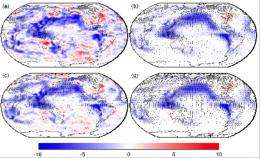Scientists find a way to distinguish the aerosol particle signal from the weather noise

(Phys.org)—Scientists developed a modeling shortcut to dial in a clearer atmospheric particle signal. A research team from the Scripps Institute of Oceanography, the University of Washington, and Pacific Northwest National Laboratory fine-tuned the winds simulated in a global climate model to better represent the winds measured in the atmosphere. Their technique increased the signal's clarity by greatly reducing the signal noise. Their work produced shorter, more efficient simulations of the global aerosol particle effects on clouds and a better reception of the atmospheric particle signal.
Although scientists agree that the Earth is warming because of increasing concentrations of greenhouse gases, there are other considerations. Increased levels of atmospheric particles, or aerosols, inside clouds can have a cooling influence. Pollution particles make the clouds brighter and more reflective by both increasing the number of cloud droplets and reducing each droplet's size. Scientists are working to find other factors that allow polluted clouds to hold more water, which would make them even brighter. Accounting for detailed features in the climate, such as the cooling effect of pollution particles on clouds, will help scientists understand past climate change and improve confidence in predictions of future climate change. This study gives climate researchers a valuable tool for those important predictions.
Aerosol particles produced by human activity are influencing climate change by making more droplets so that clouds can hold more water without raining. Isolating such aerosol effects on clouds from the influence of inherently variable effects of weather systems is fraught with difficulty. The aerosols' signature is small but persistent, yet it involves the same highly variable quantity - the amount of liquid water in the atmospheric column - that is strongly influenced by weather systems.
For this study, researchers from the Scripps Institution of Oceanography, University of Washington, and PNNL simulated aerosol effects on clouds using the Community Atmosphere Model, CAM5. They nudged simulations of pre-industrial and present day aerosols toward the same winds so that the weather systems were similar in both simulations. They also simulated pre-industrial and present day aerosols without nudging so that the weather systems could evolve freely. In both pairs of simulations, the aerosols' impact on Earth's energy balance was estimated by comparing Earth's energy balance to each pair of pre-industrial and present day aerosol simulations.
Nudging greatly reduced the variations in the column liquid water without significantly changing the sensitivity of the column liquid water to the aerosol, thus permitting global estimates of aerosol effects on clouds in much shorter simulations.
The researchers have shown that aerosols' effects on clouds can be isolated in shorter, efficient simulations. Next, they will use the same method in simulations that are much more computationally detailed.
More information: Kooperman G J, MS Pritchard, SJ Ghan, RCJ Sommerville, and LM Russell. 2012. "Constraining the Influence of Natural Variability to Improve Estimates of Global Aerosol Indirect Effects in a Nudged Version of the Community Atmosphere Model 5." Journal of Geophysical Research-Atmospheres. DOI: 10.1029/2012JD018588
Journal information: Journal of Geophysical Research - Atmospheres
Provided by Pacific Northwest National Laboratory




















